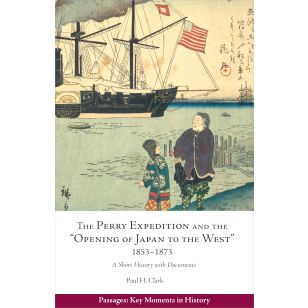The Perry Expedition and the "Opening of Japan to the West," 1853–1873
Series: Passages: Key Moments in History
"In this concise volume, Clark provides a nice split between detailed yet engaging narrative history—of the sort required to understand Japan in the context of the nineteenth century world—and primary sources that include updated translations, previously unused sources, classic texts, and helpful visual materials. A welcome addition to world, East Asian, and Japanese history courses." —Michael Wert, Marquette University
By the time U.S. Commodore Matthew Perry’s squadron of four ships sailed into Tokyo Bay on July 8, 1853, the Japanese Tokugawa government had already fended off similarly unwelcome intrusions by the French, the Russians, the Dutch, and the British. These Western imperialists had the power and the means to force Japan into the kinds of treaties that would effectively spell the end of Japan’s autonomy, maybe even its existence as an independent country. At the same moment, Japan was also grappling with a serious insurrection, the death of an emperor, and the death of a shogun—as well as with a series of natural disasters and associated famines. The Japanese response to this incredible series of catastrophes would permanently alter the balance of geopolitical power around the world.
Drawing on the best recent scholarship, this short introductory volume examines the motivations and maneuvers of the major participants in the conflict and sets the "opening" of Japan in the context of broader global history. Selections from twenty-nine primary sources provide firsthand accounts of the event from a variety of perspectives. Several illustrations are also included, along with a note on historiographic interpretation.
Reviews:
"In this concise volume, Clark provides a nice split between detailed yet engaging narrative history—of the sort required to understand Japan in the context of the nineteenth century world—and primary sources that include updated translations, previously unused sources, classic texts, and helpful visual materials. A welcome addition to world, East Asian, and Japanese history courses."
—Michael Wert, Marquette University
About the Author:
Paul H. Clark is Professor of History, West Texas A&M University.
Table of Contents
Preface
Acknowledgements
Chronology
Chapter 1: Introduction
- The Tokugawa System
- The Four Classes of Society
- The Policy of Sakoku
- Japan in the Early 19th Century
- Economic and Political History in the Early 19th Century
- Gunboat Diplomacy and Western Imperialism
- Early European Efforts to Establish Diplomatic Relations with Japan
Chapter 2: The Western Nations Attempt to Visit Japan
- France
- Great Britain
- The United States
- Commodore Perry’s Visit
- The Japanese Response
Chapter 3: The Collapse of the Tokugawa Shogunate
Chapter 4: The Dawn of the Meiji Period
- The Iwakura Embassy
- The Civilization and Enlightenment Movement
- Conclusion
- Note on Historiography
Documents
- 1. The Diminishing Resolve of the Samurai in Late Edo Japan (1796)
- 2. Infanticide, Abortion and the Effects of Poor Leadership in Agriculture (1827)
- 3. Ōshio Heihachirō’s Public Proclamation as the 1837 Uprisings
- 4. Excerpt from “Report of Captain Lindenberg, of the Russian American Company’s Ship Prince Menchikoff, to the Commander of the Colony of Sitka, October 17, 1852.”
- 5. Report From St. Helena—Cruelty of the Japanese Toward American Sailors
- 6. The Path to Profligate Living of Samurai New to Edo, 1855
- 7. First Contact (1853)
- 8. Letter from Commodore Matthey C. Perry [Sent in Connection with the Delivery of a White Flag] to unknown Japanese Authorities, July 14, 1853
- 9. Letter from Millard Fillmore, President of the United States of America, To His Imperial Majesty, the Emperor of Japan (written in 1852, Delivered by Commodore Perry in 1853)
- 10. Letter from Commodore Matthew C. Perry to the Emperor of Japan (1853)
- 11. Treaty of Kanagawa, March 31, 1854
- 12. Japanese Map of the World (1850s)
- 13. Commodore Perry’s Fleet as Depicted in an 1853 Woodblock Print
- 14. A U.S.-Produced Lithograph of the Meeting Between Commodore Perry and the Japanese in 1853
- 15. Japanese Woodblock Print of Commodore Perry at 60 Years Old (1854)
- 16. On Coastal Defense (1853)
- 17. Memorial on Foreign Intercourse Presented to the Shōgunate by Ii Kamon no Kami (Ii Naosuke) in 1853
- 18. One Letter to the Shogunate from the Major Daimyō in Response to U.S. Demands (1853)
- 19. “Proposal for Reforming Japan, 1862
- 20. The United States Seeks Special Access to Some of Japan’s Harbors (1855) and the Response from Japan
- 21. Journal Entry of Townsend Harris, First U.S. Envoy to Japan, Tuesday August 27, 1856
- 22. Convention Between Great Britain and Japan (1854)
- 23. Treaty Between Russia and Japan (1855)
- 24. Murder In Yokohama 1859)
- 25. Manifesto Announcing the Shōgun’s Abdication, November 8, 1867
- 26. Charter Oath of April 6, 1868
- 27. The Abolition of Feudalism (1869)
- 28. Conscription Regulations (1873)
- 29. Letter from the Emperor of Japan to President Ulysses Grant on the Occasion of the Iwakura Embassy’s Visit to the United States (1872)
Bibliography
Index







